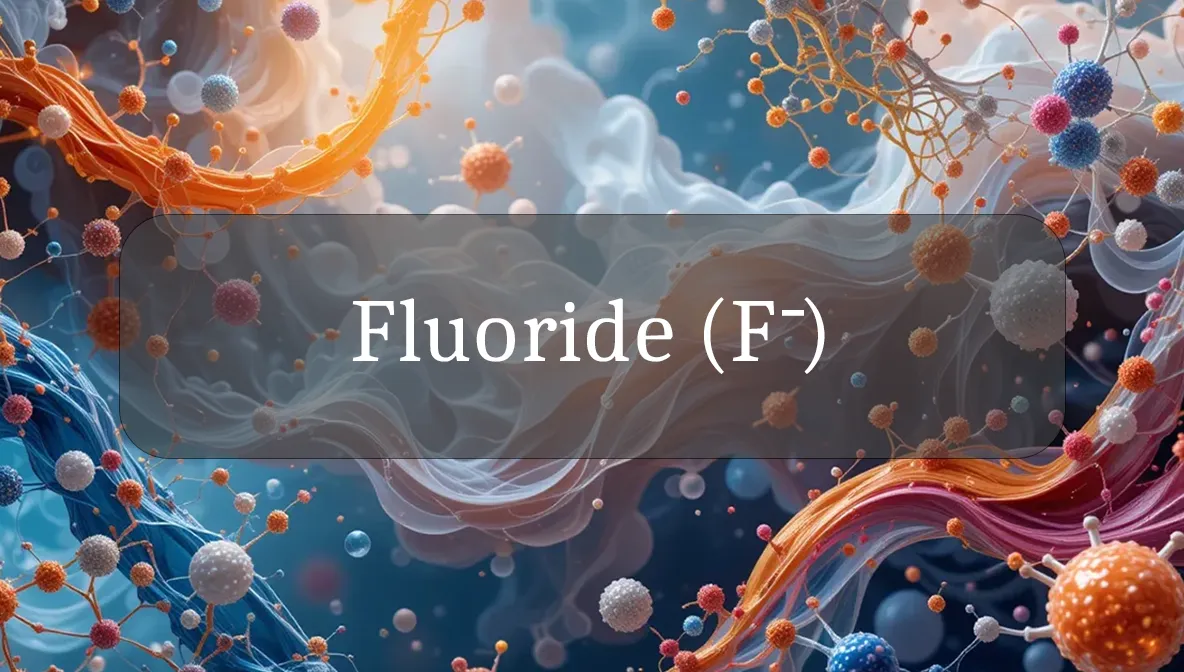Teeth’s Protective Shield
Fluoride (F⁻) is a naturally occurring mineral ion that plays a key role in strengthening teeth and supporting dental health. Found in water, foods, and dental products, it’s a vital nutrient in small amounts but requires careful management to avoid potential risks from excessive exposure. Let’s explore what fluoride is, its role in your wellness, and how to balance its benefits for daily vitality.
Identity and Function
Fluoride is the negatively charged ion of the element fluorine, a halogen with a molecular weight of ~19 Da. It integrates into the crystal structure of tooth enamel as fluorapatite, making it more resistant to acid erosion from bacteria. Fluoride also inhibits bacterial enzymes, reducing acid production in plaque. It’s absorbed in the gut, distributed via blood, and primarily stored in bones and teeth, with excess excreted by kidneys.
Biological Role and Health Impact
Fluoride is essential for dental health and has broader health implications:
- Dental Protection: It strengthens enamel, reducing cavities (dental caries) by up to 25% in communities with fluoridated water. It promotes remineralization, repairing early tooth decay.
- Bone Health (Minor Role): Fluoride may support bone density by incorporating into bone mineral, but excessive amounts can weaken bones.
- Antibacterial Effect: It disrupts plaque bacteria (e.g., Streptococcus mutans), lowering caries risk and supporting oral hygiene.
- Public Health Impact: Water fluoridation (0.7–1.2 ppm) is a cost-effective measure, reducing dental costs and improving quality of life, especially for children.
- Systemic Balance: Optimal fluoride intake (0.05 mg/kg/day) supports teeth without toxicity, maintaining oral and overall health.
By protecting teeth and supporting oral health, fluoride enhances confidence, reduces dental pain, and supports general well-being.
Production and Sources
Fluoride is not produced by the body but obtained externally:
- Natural Sources: Found in water (varies by region, 0.1–4 ppm), soil, and foods like fish (sardines, 0.2 mg/100g), tea (black tea, 0.1–0.4 mg/cup), and grapes.
- Dietary Sources: Fluoridated water, toothpaste (1000–1500 ppm), mouth rinses, and supplements (in non-fluoridated areas, prescribed for children).
- Key Nutrients: Calcium (milk, yogurt) and vitamin D (salmon, eggs) support enamel formation, complementing fluoride’s effects. Hydration aids fluoride metabolism.
- Environmental Exposure: Industrial emissions or fertilizers may increase fluoride in water or crops, but levels are regulated in most regions.
A balanced diet and access to fluoridated products ensure adequate fluoride intake.
Signs of Imbalance
Fluoride imbalances, from deficiency or excess, can affect health:
- Fluoride Deficiency:
- Increased cavity risk, tooth sensitivity, or enamel erosion, especially in children or in non-fluoridated areas.
- Symptoms: Tooth pain, visible decay, or frequent dental issues.
- Fluoride Excess (Fluorosis):
- Dental Fluorosis: White streaks or brown spots on teeth from high intake during tooth development (ages 0–8), affecting appearance but not function.
- Skeletal Fluorosis (Rare): Joint pain, stiffness, or brittle bones from chronic high exposure (>10 mg/day, typically from contaminated water).
- Symptoms: Cosmetic tooth changes, bone pain, or reduced mobility in severe cases.
- Toxicity (Acute, Rare):
- Nausea, vomiting, or abdominal pain from ingesting large amounts (e.g., swallowing toothpaste, >5 mg/kg body weight). Blood fluoride >0.2 mg/L indicates toxicity.
If you notice tooth discoloration, joint pain, or dental issues, see a dentist or doctor for tests like urine fluoride levels or bone imaging.
Supporting Healthy Function
To optimize fluoride benefits and avoid risks:
- Use Fluoridated Products: Brush twice daily with fluoride toothpaste (pea-sized amount for kids <3, smear for <2) and rinse with water, not mouthwash, to retain fluoride. Use fluoridated water (0.7 ppm) for drinking and cooking.
- Monitor Intake in Kids: Supervise children’s brushing to prevent swallowing toothpaste. Avoid fluoride supplements unless prescribed in non-fluoridated areas.
- Eat a Balanced Diet: Include calcium-rich foods (cheese, almonds) and vitamin D (eggs, mushrooms) to support enamel and bone health, enhancing fluoride’s effects.
- Check Water Sources: Test well water for fluoride levels if not on public supply; aim for 0.7–1.2 ppm. Use filters if levels are too high (>4 ppm).
- Regular Dental Checkups: Visit a dentist every 6 months for cleanings and fluoride treatments (e.g., varnishes for kids), especially in high-risk groups.
Safety and Precautions
Fluoride is safe in recommended doses but requires care:
- Medical Conditions: Kidney disease may impair fluoride excretion, increasing toxicity risk. Monitor with your doctor. Thyroid concerns are unproven at standard doses.
- Excessive Exposure: Avoid high-fluoride water (>4 ppm) or overuse of supplements. Industrial workers handling fluoride compounds need protective gear per OSHA standards.
- Children’s Safety: Use age-appropriate toothpaste amounts and store products out of reach to prevent accidental ingestion. Dental fluorosis is cosmetic but preventable.
- Controversies: Some claim fluoride causes neurological or systemic harm, but studies (e.g., CDC, WHO) confirm safety at 0.7–1.2 ppm. Discuss concerns with a healthcare provider.
- Acute Toxicity: Seek immediate care for suspected overdose (e.g., nausea, seizures); call poison control and administer calcium (milk) to bind fluoride.
If you have dental concerns, joint pain, or questions about fluoride sources, consult a dentist or healthcare provider for tests like fluoride levels or dental exams.
Fun Fact
Did you know fluoride was first linked to healthier teeth in the 1930s when scientists noticed fewer cavities in areas with naturally high-fluoride water? This discovery led to water fluoridation, one of the top public health achievements of the 20th century!
Citations
- National Institutes of Health (NIH): Fluoride and Dental Health.
- Centers for Disease Control and Prevention (CDC): Community Water Fluoridation.
- American Dental Association (ADA): Fluoride in Dentistry.
- Journal of Dental Research: Fluoride and Caries Prevention (2020).
- World Health Organization (WHO): Fluoride in Drinking Water (2019).

